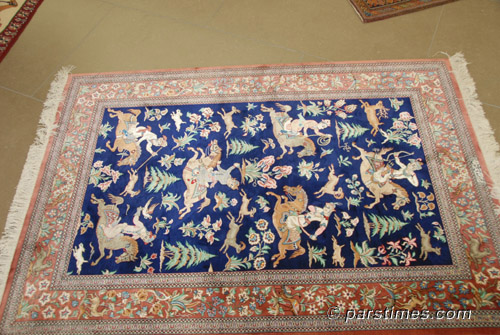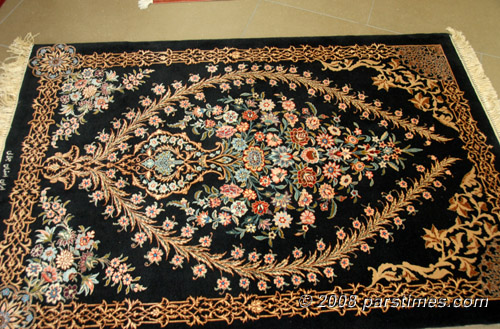

Carpet DesignsIran Today; Economic Magazine (Monthly) Sept. & Oct. 1997, No. 16 Pages: Pages: 60-61 Oriental carpets, particularly those of Persia, are well known. The finest carpets in museums all over the world are usually Persian carpets woven by Iranian. These carpets reveal the Iranians' mastery of the art and craft of carpet weaving. Ghali (Persian word for Carpet), according to Moin's lexicon and Professor Pope's survey of Persian art, is derived from the name of an Armenian city, Ghalighala. Carpets reveal the link between the weavers' material and spiritual needs. It reflects the living conditions and cultural status of the people, as well as the land's climatic conditions, botanical resources and geographical conditions. In fact, the roots of carpet weaving must be looked for in nomadic life from where it found its way to the villages and cities. Nomads use the wool of livestock and the dyes made from a variety of plant resources. Carpet weaving reveals the Iranians' taste for artistic utility throughout history. Carpets not only have everyday usage, but are regarded as objects of art. The nomadic Iranians wove beautiful carpets to cover and decorate floors and other parts of their tents. They also made rugs, kilims, blankets, saddles and tent ribbons. Each carpet consists of strings of weft and thousands of Persian or Turkish knots that constitute the carpet's warp. The material used could be cotton, wool or silk. The strings of warp and weft are usually made of cotton, and sometimes wool, but seldom silk. The wooden or metal frame, on which the strings are attached vertically, is installed either vertically or horizontally. The weaver then uses thousands of knots of dyed strings to weave the carpet. Unlike the nomadic weavers, others usually use designed patterns for weaving the carpets. After every few knots, the wefts are leveled with a heavy pressing device.
Iranian carpet designers and craftsmen have derived inspiration from
nature for creating their enchanting works of art. The constituent
parts of a design include the design of the main part and that of the
margins. The margins make a frame around the main body of the
carpet and usually have three sections. The size and pattern of the
carpet determine the main margin's design. There are two other
narrower margins that decorate the main margin.
 Designs may be broadly categorized into types, namely revolving and broken. The revolving designs are made of curved lines that are drawn on checkered paper. The broken ones comprise simple, straight lines, which need not be drawn on paper. These are of greater interest to rural and nomadic weavers. The most well known carpet designs are Triangular Citron, Prayer-Niche, Vase, Framed, Tree, Floral, Shah Abbas, Arabesque, Kings & Noblemen, European Flower, Mixed Fish, Striped Pattern and four Seasons (Heart). Many of these have other variations. Tringular Citron (Lachak Toranj): First used for the decoration of leather book-covers, it is one of the most beautiful and popular Iranian designs. It has been used in carpets since the 10th century Hegira. The citron design is usually round and sometimes elliptical. One-fourth of a citron design appears at every angle of the carpet's main body. Prayer-Niche (Mehrabi): This design has been inspired by prayer-niche of Muslim mosques, but some other decorative elements like columns, flowers and leaves have been added to it later. The variations of these designs are named after the name of the added element. Vase (Goldani): This design consists of different types and sizes of flower vases, which are at times full of flowers and fill the main part of the carpets. Sometimes a number of symmetrical or otherwise arranged vases decorate the entire carpet. The variations of this design are the two side vases, the Altar Vase, and the Zellolsultan Vase. Framed (Ghabghabi): This is one of the famous designs in the art of carpet weaving. Sometimes the designs of its four-sided frames are the same, but in other cases these designs differ from each other. One of the most beautiful specimens of this design is displayed at the Iran Carpet Museum and includes scenes from the stories of Shahnameh. Tree (Derakhti): This design includes magnificent trees, seen in the carpets of royal courts, while simpler trees are seen in those woven by villagers and nomadic tribes. Floral (Botteh): This design has been used since thousands of years on precious carpets and other works of art. The Floral design has several variations, including small, medium and large chestnut and mother & child design, in which a smaller design comes out of a larger one. The friendship and enmity design, which is more popular in the Seneh carpets woven in Sanandaj area, belongs to this category. The floral design and its variations are very popular in the provinces of Khorasan, Kerman, Kordestan, the Central Province, and among the Ghashghai and Bakhtiari tribes where it is known as Ghobad Khani and Garden design respectively.
 Shah Abbas: This design is based on a floral pattern, which has been popular since time of the Safavid dynasty, and is known as the Shah Abbas design. Its abstract floral designs combined with Arabesque designs comprise the main pattern and the margin of these carpets. There are several variations of the Shah Abbas design like the Sheikh Safi, the Floral and the Animal designs. Arabesque (Eslimi): This plant-like curved pattern has probably found its way into the Persian art from the Arabic art. The Persian word for Arabesque (Eslimi) has probably been derived from the word Eslimi meaning bud. It may possibly be a variation of the word Eslam that stands for the religion of Islam. One of the most famous types of this pattern is the Dahan Azhdari found in abundance in the Bijar carpet. In this form, the ending part of each branch is divided into two parts that resemble the jaws of a dragon. Kings & Noblemen: This is one of the rare designs found in the carpets of Kerman that depicts portraits of kings and world-renowned men. Christopher Columbus, Abraham Lincoln, George Washington, Alexander and Napoleon are among the famous men whose portraits have appeared on such carpets. These carpets are mainly woven in Kerman and occasionally in Tabriz at customer's demand. European Flower (Gol Farang): This design is worked mainly in Kordestan, particularly in Bijar. The floral patterns in this design do not resemble those appearing in Shah Abbas or Arabesque design. Mixed Fish: Woven first in Herat, it is also known as the Herat design. Herat, presently a part of Afghanistan, was an Iranian city until 1587. This design has four fish around a carpet. The picture of the fish is at times so abstract and stylized that it hardly resembles a fish and looks more like a leaf. This design is popular in Kordestan, Azarbaijan and the Central Province. It is also known as the Farahan design because the carpet-weavers of Farahan are expert in weaving carpets with fish or Herat design. Striped Pattern: In this pattern, the carpet is decorated with long and narrow strips of different designs and harmonious colors. In some areas of Iran, this pattern is called Ghalamdani design. Four Seasons: This is one of the most interesting designs used since the last few centuries. It consists of four pictures, each depicting one season of the year. These beautiful carpets have been woven only in Tabriz and Haris. The Astrolabe design woven in Isfahan and presently displayed at Iran Carpet Museum is another unique design. It is the artistry of the carpet weaver that combines these designs with suitable colors and casts a fascinating spell on the beholder.
|